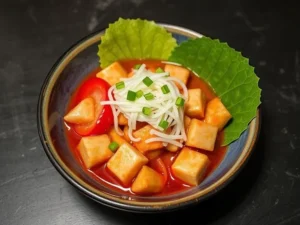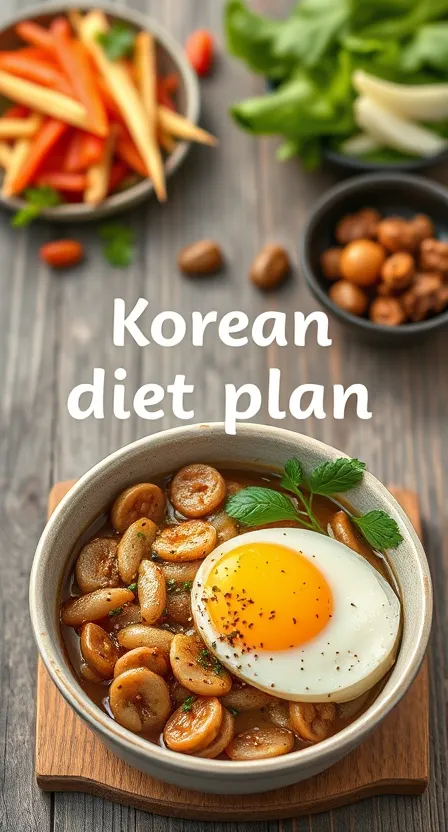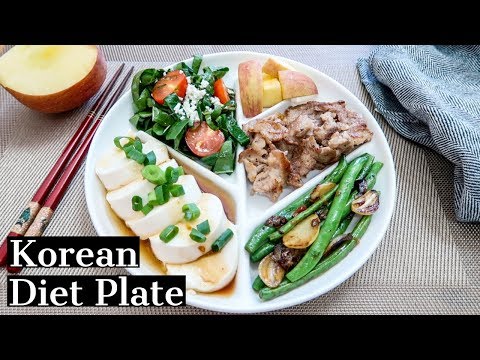The Korean diet plan has gained global attention for its emphasis on fresh, nutrient-dense foods and its potential to promote weight loss and overall health. Rooted in traditional Korean eating habits, this diet focuses on balance, variety, and moderation. In this comprehensive guide, we’ll explore the principles of the Korean diet, its benefits, sample meal plans, and tips for success. Whether you’re looking to lose weight, improve your health, or simply enjoy delicious meals, this guide has you covered.
What is the Korean Diet Plan?
The Korean diet plan is a traditional eating pattern that emphasizes whole, unprocessed foods like vegetables, rice, seafood, and fermented foods like kimchi. It’s known for its balance of macronutrients (carbs, protein, and fats) and its focus on portion control. Unlike restrictive diets, the Korean diet is sustainable and enjoyable, making it a popular choice for those seeking long-term health benefits.
Key Principles of the Korean Diet
- Whole, Unprocessed Foods: The diet prioritizes fresh vegetables, fruits, lean proteins, and whole grains.
- Fermented Foods: Foods like kimchi, doenjang (soybean paste), and gochujang (chili paste) are staples, promoting gut health.
- Low in Processed Foods: The diet avoids processed snacks, sugary drinks, and fast food.
- Portion Control: Meals are served in small portions, often with a variety of side dishes (banchan) to ensure balance.
- Cultural Practices: Eating slowly, savoring meals, and sharing food are integral to the Korean diet.
Benefits of the Korean Diet
- Weight Loss: The diet’s focus on low-calorie, nutrient-dense foods supports healthy weight loss.
- Improved Digestion: Fermented foods like kimchi promote gut health and digestion.
- Heart Health: The diet is rich in vegetables, seafood, and healthy fats, which are beneficial for cardiovascular health.
- Skin Health: Antioxidant-rich foods like seaweed and green tea contribute to glowing skin.
- Sustainability: The diet is easy to follow long-term, making it a practical choice for healthy eating.
7-Day Korean Diet Meal Plan
Here’s a sample 7-day meal plan to help you get started with the Korean diet:
Day 1
- Breakfast: Steamed rice, grilled mackerel, and kimchi.
- Lunch: Bibimbap (mixed rice with vegetables, beef, and gochujang sauce).
- Dinner: Doenjang jjigae (soybean paste stew) with tofu and vegetables.
Day 2
- Breakfast: Kimchi fried rice with a fried egg on top.
- Lunch: Japchae (stir-fried glass noodles with vegetables and beef).
- Dinner: Grilled pork belly (samgyeopsal) with lettuce wraps and ssamjang (dipping sauce).
Day 3
- Breakfast: Seaweed soup (miyeokguk) with steamed rice.
- Lunch: Kimchi stew (kimchi jjigae) with tofu and pork.
- Dinner: Grilled chicken with a side of seasoned spinach and bean sprouts.
Day 4
- Breakfast: Steamed sweet potatoes and a boiled egg.
- Lunch: Haemul pajeon (seafood pancake) with soy dipping sauce.
- Dinner: Bulgogi (marinated beef) with steamed rice and kimchi.
Day 5
- Breakfast: Rice porridge (juk) with vegetables and sesame oil.
- Lunch: Tteokbokki (spicy rice cakes) with fish cakes and boiled eggs.
- Dinner: Grilled salmon with a side of seasoned zucchini and mushrooms.
Day 6
- Breakfast: Kimchi pancake (kimchijeon) with a side of pickled radish.
- Lunch: Sundubu jjigae (soft tofu stew) with seafood.
- Dinner: Grilled beef ribs (galbi) with steamed rice and lettuce wraps.
Day 7
- Breakfast: Steamed rice with seasoned seaweed (gim) and a boiled egg.
- Lunch: Korean-style fried chicken with a side of pickled vegetables.
- Dinner: Samgyetang (ginseng chicken soup) with rice and kimchi.
Delicious Recipes for the Korean Diet Plan
The Korean diet plan is celebrated for its flavorful, nutrient-dense meals that promote health and weight loss. Below are three easy and authentic recipes to help you incorporate the principles of the Korean diet into your daily routine. These recipes are simple, delicious, and packed with wholesome ingredients.
1. Kimchi Fried Rice (Kimchi Bokkeumbap)
Kimchi fried rice is a quick, flavorful dish that’s perfect for breakfast, lunch, or dinner. It’s packed with probiotics from kimchi and can be customized with your favorite proteins.

Ingredients:
- 1 cup cooked rice
- ½ cup kimchi (chopped)
- 1 tablespoon gochujang (Korean chili paste)
- 1 fried egg
- 1 teaspoon sesame oil
- 1 green onion (chopped)
- Optional: 100g cooked beef, chicken, or tofu
Instructions:
- Heat sesame oil in a pan over medium heat.
- Add kimchi and sauté for 2–3 minutes.
- Stir in cooked rice and gochujang, mixing well.
- Cook for 5–7 minutes until heated through.
- Top with a fried egg and garnish with green onions. Serve immediately.
2. Doenjang Jjigae (Soybean Paste Stew)
This hearty stew is a staple of the Korean diet, featuring fermented soybean paste (doenjang) for a rich, savory flavor. It’s packed with vegetables and tofu for a nutritious meal.
Ingredients:
- 2 cups water
- 2 tablespoons doenjang (soybean paste)
- 100g tofu (cubed)
- ½ cup zucchini (sliced)
- ½ cup mushrooms (sliced)
- ½ cup kimchi
- 1 green onion (chopped)
- 1 teaspoon sesame oil
Instructions:
- Bring water to a boil in a pot.
- Add doenjang and stir until dissolved.
- Add tofu, zucchini, mushrooms, and kimchi. Simmer for 15 minutes.
- Drizzle with sesame oil and garnish with green onions. Serve with steamed rice.
3. Japchae (Stir-Fried Glass Noodles)
Japchae is a colorful, flavorful dish made with sweet potato noodles, vegetables, and a touch of sesame oil. It’s a great option for a balanced meal.
Ingredients:
- 100g sweet potato noodles
- 100g beef (thinly sliced)
- 1 cup spinach
- ½ cup carrots (julienned)
- ½ cup mushrooms (sliced)
- 2 tablespoons soy sauce
- 1 tablespoon sugar
- 1 teaspoon sesame oil
- 1 teaspoon sesame seeds
Instructions:
- Cook sweet potato noodles according to package instructions. Rinse and set aside.
- Sauté beef in a pan until cooked through. Remove and set aside.
- In the same pan, stir-fry spinach, carrots, and mushrooms until tender.
- Add cooked noodles, beef, soy sauce, sugar, and sesame oil. Mix well.
- Garnish with sesame seeds and serve warm.
Why These Recipes Work
- Balanced Nutrition: Each recipe includes a mix of protein, carbs, and healthy fats.
- Fermented Foods: Kimchi and doenjang provide probiotics for gut health.
- Portion Control: These recipes are designed to be filling without overeating.
- Easy to Prepare: Simple ingredients and quick cooking times make these recipes perfect for busy lifestyles.
These Korean diet recipes are a delicious way to enjoy the health benefits of traditional Korean cuisine. Whether you’re looking to lose weight, improve your digestion, or simply enjoy flavorful meals, these recipes are a great place to start. For more meal ideas, explore our other articles on KetoGuider. Let’s get cooking!
10 FAQs About the Korean Diet Plan
1. What is the Korean diet plan?
The Korean diet plan is a traditional eating pattern that emphasizes whole, unprocessed foods like vegetables, rice, seafood, and fermented foods like kimchi.
2. Can I lose weight on the Korean diet plan?
Yes, the Korean diet plan is known for promoting weight loss due to its focus on low-calorie, nutrient-dense foods and portion control.
3. Is the Korean diet suitable for vegetarians?
Yes, the diet can be customized for vegetarians by focusing on plant-based proteins like tofu, beans, and mushrooms.
4. What are the staple foods in the Korean diet?
Staple foods include rice, kimchi, vegetables, seafood, tofu, and fermented sauces like doenjang and gochujang.
5. Can I follow the Korean diet if I have dietary restrictions?
Yes, the diet is flexible and can be adapted to suit dietary restrictions like gluten-free or dairy-free.
6. Are there any side effects of the Korean diet?
The diet is generally safe, but some people may experience digestive discomfort from fermented foods if they’re not used to them.
7. How long should I follow the Korean diet plan?
The diet is designed for long-term use, but you can follow it for as long as you need to achieve your health goals.
8. Can I exercise while on the Korean diet?
Yes, light to moderate exercise is recommended to support weight loss and overall health.
9. What foods should I avoid on the Korean diet?
Avoid processed foods, sugary snacks, and sugary drinks.
10. Where can I find Korean diet recipes?
You can find recipes in Korean cookbooks, online resources, or by customizing the meal plan provided in this guide.
The Korean diet plan is a delicious, sustainable, and effective way to improve your health and achieve your weight loss goals. By following the principles, meal plans, and tips outlined in this guide, you’ll be well on your way to enjoying the benefits of this traditional eating pattern. For more nutrition and fitness tips, explore our other articles on KetoGuider. Let’s get started!
Review of the Korean Diet Plan from a USA Perspective
The Korean diet plan has gained popularity in the USA for its emphasis on fresh, nutrient-dense foods and balanced meals. As someone who has tried this diet, I can confidently say it’s one of the most enjoyable and sustainable eating plans I’ve encountered.
What I Loved
- Flavorful and Satisfying: The Korean diet is anything but boring. Dishes like kimchi fried rice, bibimbap, and doenjang jjigae are packed with flavor and keep me excited about meals.
- Focus on Whole Foods: The diet prioritizes whole, unprocessed ingredients like vegetables, rice, seafood, and fermented foods, which align well with my goal of eating cleaner.
- Portion Control: The small portions and variety of side dishes (banchan) make it easy to avoid overeating without feeling deprived.
- Health Benefits: I noticed improved digestion and energy levels, likely due to the probiotics in fermented foods like kimchi and doenjang.
Challenges
- Ingredient Accessibility: Some ingredients, like gochujang (Korean chili paste) or fresh kimchi, can be hard to find in regular grocery stores. I had to visit an Asian market or order online.
- Time-Consuming Prep: While the meals are delicious, some recipes require more prep time than I’m used to. Meal prepping helped, but it’s still a commitment.
- Spice Level: As someone not used to spicy food, some dishes were a bit too hot for my taste. I’ve learned to adjust the amount of gochujang or kimchi to suit my preference.
Final Thoughts
The Korean diet plan is a fantastic option for anyone looking to eat healthier, lose weight, or simply enjoy delicious meals. Its focus on balance, variety, and fresh ingredients makes it a sustainable choice for long-term health. While there are some challenges, like finding specialty ingredients, the benefits far outweigh the drawbacks.
For more tips and recipes, check out our guide on Healthy Eating Tips. The Korean diet plan is definitely worth trying if you’re ready for a flavorful, healthy lifestyle!

